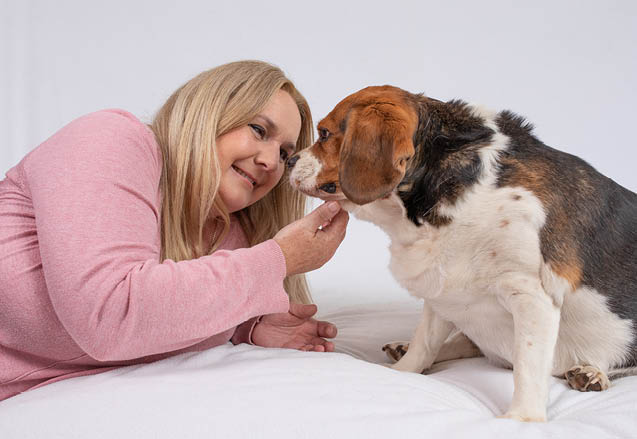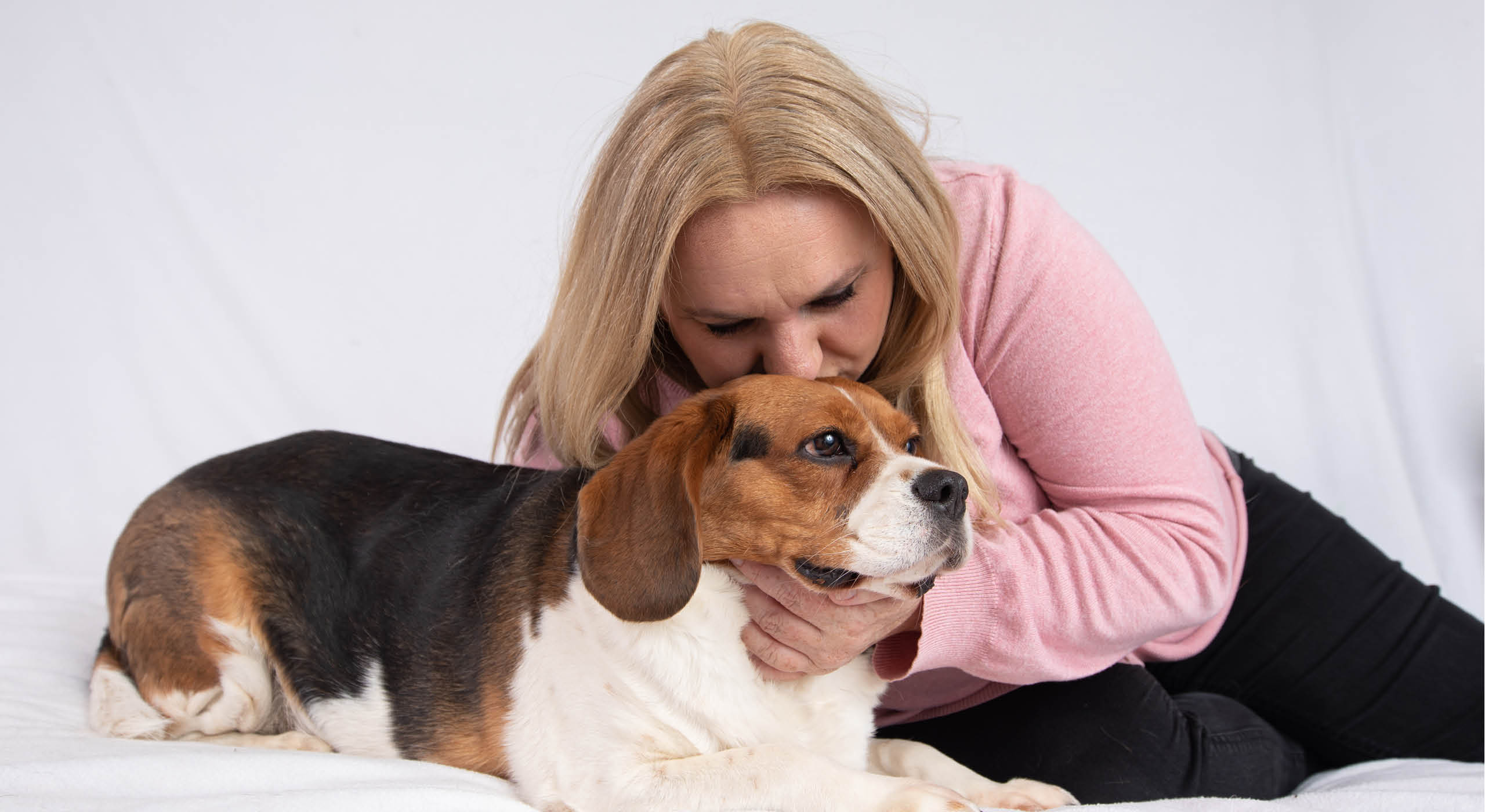As her partner’s behaviour became increasingly erratic, Jennifer Howard knew she had to leave. Lately the violence had escalated; he had threatened her with a knife in front of their children, then aged two and four, and chased her round their trampoline with a shotgun.
But like many women fleeing family violence, Jennifer’s decision was complicated by the knowledge that in going to a women’s shelter, she would have to leave behind two other members of her family: her dogs, Missy and Ballsy.
“I’d had them since they were puppies,” she says. “It was heartbreaking.”
Ultimately, with her children in danger, Jennifer made the only choice she felt she could. After failing to convince friends and family in Adelaide to care for the dogs, she moved into a shelter and Missy and Ballzy ended up at the pound.
“It was a decision that still haunts me,” she says now. “Especially my female dog, Missy – she would have just cried and howled for me.”
Jennifer later discovered that the animals were highly likely to have been euthanased.
“They were eight years old – they should have died of old age, with me,” she says, emotion in her voice. “And for the children… the dogs were their first best friends.”
It was a decision that still haunts me
Few women’s shelters are able to take pets, which means the vast majority of women in Jennifer’s situation are forced to make the same devastating choice. Many of them delay leaving; one study found that 60 per cent of family violence victims stayed in violent homes because they didn’t want to abandon their pets.
The link between pet abuse and family violence is well-documented. About 70 per cent of family violence survivors report that the perpetrator is also abusing or neglecting pets. In the US, studies have found that men who abuse or kill pets are more dangerous – more likely to stalk and kill their partners.
Services to help family violence survivors and their pets have traditionally received little funding, and they’re mainly founded and run by volunteers. Paws and Recover, for example, an animal foster-care service based in Sydney, is run by full-time policewoman Jacki Largo in her spare time. But there are signs of change.
Just this week, NSW Animal Justice MP Emma Hurst hosted a round-table meeting with survivors, animal welfare experts, vets and police to discuss what key legislative changes needed to be made to better protect the human and animals victims of domestic violence.
Issues highlighted at the meeting included the need for animals to be included in protection orders [ADVOs] and changes to tenancy laws. Attorney General Mark Speakman has signalled he is open to their proposals.
“Ideally we need to keep the victim and the animals together,” Hurst says. “We need tenancy reform, as it can be near impossible for women to find rental accommodation that will allow them to keep their [pets].” One study found that 70 per cent of women fleeing family violence with their animals were turned away from government-funded accommodation, with a third facing rejection from family and friends.


Once she’d secured long-term accommodation for herself and her children, Jennifer approached her local women’s shelter in Adelaide to offer foster care for pets. “I just didn’t want anyone else to go through what I had,” she says.
The facebook community of volunteers Jennifer started in 2013 has grown into Safe Pets Safe Families, a foster-care charity for pets that now comprises over 350 volunteers. As well as coordinating care for animals ranging from dogs and cats to more unusual pets like reptiles and llamas (and even, once, a camel), Safe Pets offers animal behavioural therapy for pets who’ve been traumatised by what they’ve seen and experienced.
“Ideally, we’d like to have our own facility so we can help them, because sometimes they develop behavioural issues, like biting, which makes them harder to place,” Jennifer says, adding that she and other volunteers are studying force-free pet training in an attempt to help. “It’s not that they’re bad dogs, they just feel fear.”
I didn’t want anyone else to go through what I had
“Men use tactics like preventing a woman from touching or feeding an animal, making her watch it starve,” says Youna Kim, general manager of EDVOS, a family violence service in Melbourne. “Or the perpetrator will hurt an animal in front of her children, as a way of demonstrating power and control.”
Just like humans, animals are often left physically and psychologically scarred by these experiences. “I lived with a dog that had been abused by a man and she wouldn’t go near men for the next 17 years – the rest of her life,” says Associate Professor Nik Taylor of the University of Canterbury, Christchurch, who has conducted studies into human-animal relations. “She clearly remembered it. During our research we were told about animals who were previously house trained and had started soiling. Some stopped eating. One woman told us her dog developed hives that she scratched until they became infected.”
Women and children will place themselves in danger to protect their animals. More than half of family violence victims stay in abusive situations because they don’t want to leave their pets behind, and 15 per cent of women have returned to violent homes to protect them.
Women and children will place themselves in danger to protect their animals
When Amy* decided to leave her violent husband, she feared for the safety of her cat, a Burmese she’d named Silky. Once, Amy’s husband had “drop-kicked” Silky out of the house, leaving her deaf in one ear and with a suspected fractured back. “Silky was terrified of my husband, and would slink away down the hallway whenever she saw him,” Amy says over email.
“When it was time for me to leave him, I couldn’t get my cat and my child out safely together. There was an altercation with my husband on the way to pick up my child from day care and I had to make a statement to the police.
“I wasn’t going to return to our rental property, but Silky was sitting by herself in the front room waiting for her dinner. I knew if I didn’t go and get her she would start meowing, and my husband would get angry, and who knows what he would do to her.
“I left my child in the car with my mum down the street and I braved the wrath of my husband to get my cat. There was no other choice. There was no one that could help me. So I went back and got attacked. I managed to get out with Silky in a cat backpack on my back.”
Amy is now in what she describes as “an extremely high-risk situation” and has been moved into transitional accommodation with her child. Silky is in animal foster care with Sydney charity Paws and Recover, and while Amy is grateful that her cat is safe, she is also desperate to get her back.
“Silky and I have been through so much trauma together and now my best friend through all of this horrible nightmare is separated from me until I can rebuild our lives,” she says.
Foster care for animals is an important part of the picture, says Professor Taylor, but it can’t be the only solution. “Our research shows we need more shelters where women and animals can stay together, because separation is just a double trauma. Keeping the family unit together is so important.”
*Names have been changed
For more information about Safe Pets Safe Families, visit their facebook page here
“I couldn’t sleep at night worrying about the pets left behind”
In 2010, Sydney policewoman Jacki Largo established Paws and Recover, which helps find temporary foster care for pets
“In my early days of policing, I’d often be called out to jobs involving domestic violence or mental health incidents. As people were being taken to hospital or into custody, I’d notice sometimes that there was a dog or cat left behind in the apartment, and I wondered who’d look after them while their owners were away.
I started putting out bowls of water or any food I could find, and I’d tell the social worker or paramedic that there was an animal that needed care, but it wasn’t good enough – I just couldn’t sleep at night wondering what had happened to them.
I realised there was a need for short-term foster care for animals, so I started Paws and Recover. It was just me, initially. I had business cards printed and I’d take them to the local dog park and sort of cold-call people into becoming volunteers. And I took in pets myself – at one point, I had 12 dogs at home that I’d pile into the car and take for walks.
Social media has been a game-changer for us. If we’re contacted for help, we put a non-identifying post up on facebook. A carer submits an application and we perform a home and identification check, and decide if it’s the right environment for the pet. Then we transport the pet from the owner to the foster carer. Separation from a pet can be really hard, so the foster carer sends us photographs that we pass on to the owner and post to our page. At the moment we have 135 pets in care, for anything from one week to six months.
Owners find it heartbreaking to leave their animals – if a woman is leaving an abusive domestic situation, this is another fracture in her family life. They come to us when they really don’t have any other options. Yet although we’re a volunteer organisation, we will usually be able to help, and in a terrible situation we give these women hope.”
Paws and Recover relies on donations – giving as little as $1 a day can make a difference. You can visit their facebook page here
“We educate vets in the signs of family violence”
Youna Kim is the general manager of EDVOS, which runs a programme to educate veterinarians in how to recognise signs of domestic abuse – and what to do when they see them
“Pets are often the easiest targets for perpetrators because they’re a means for them to demonstrate power and control, and to create fear.
So, if a vet sees an animal that has visible malnutrition, or poor hygiene or repeated wounds, these could be signs of violence in the home.
Last year, we launched a programme, Animals 3-Rs, which helps vets to recognise the signs of violence, respond appropriately, and refer victims to family violence services. The programme was inspired by Hair 3-Rs, which trained hairdressers in the signs of abuse – so far, we’ve trained 550 hairdressers nationwide.
For Animal 3Rs, we’ve been educating vets in how to respond to a woman who brings in an animal to the surgery. The vets’ role is to believe a woman if she discloses abuse, respect her decision if she doesn’t want to seek any further referrals, and to provide information if she does.
You have to be careful not to endanger victims by giving information a perpetrator might find. Vets can have brochures in the waiting room, posters on toilet doors; they can wear a 3Rs badge to spark conversation.
With the University of Melbourne, we evaluated our programme using questionnaires that the vets completed before and after training. Vets felt overwhelmingly more confident in spotting the signs of abuse and 80 per cent felt able to refer victims of family abuse to the right services. The next step for us is to roll out the programme nationally.”
For more information, visit the Animal-3Rs facebook page; you can donate to the programme here














No Comments